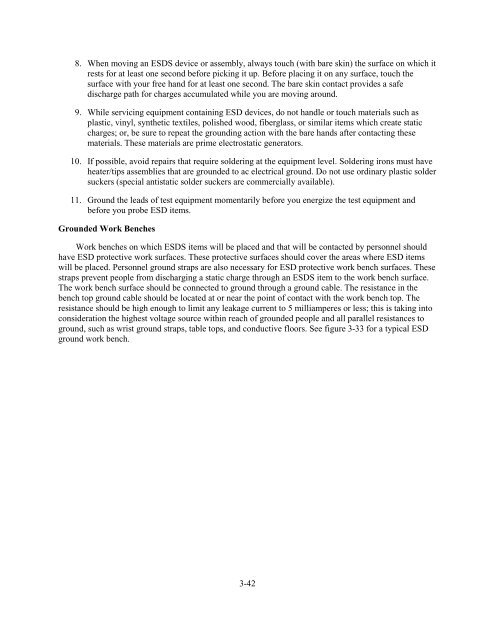Navy Electricity and Electronics Training Series - Historic Naval ...
Navy Electricity and Electronics Training Series - Historic Naval ...
Navy Electricity and Electronics Training Series - Historic Naval ...
You also want an ePaper? Increase the reach of your titles
YUMPU automatically turns print PDFs into web optimized ePapers that Google loves.
8. When moving an ESDS device or assembly, always touch (with bare skin) the surface on which itrests for at least one second before picking it up. Before placing it on any surface, touch thesurface with your free h<strong>and</strong> for at least one second. The bare skin contact provides a safedischarge path for charges accumulated while you are moving around.9. While servicing equipment containing ESD devices, do not h<strong>and</strong>le or touch materials such asplastic, vinyl, synthetic textiles, polished wood, fiberglass, or similar items which create staticcharges; or, be sure to repeat the grounding action with the bare h<strong>and</strong>s after contacting thesematerials. These materials are prime electrostatic generators.10. If possible, avoid repairs that require soldering at the equipment level. Soldering irons must haveheater/tips assemblies that are grounded to ac electrical ground. Do not use ordinary plastic soldersuckers (special antistatic solder suckers are commercially available).11. Ground the leads of test equipment momentarily before you energize the test equipment <strong>and</strong>before you probe ESD items.Grounded Work BenchesWork benches on which ESDS items will be placed <strong>and</strong> that will be contacted by personnel shouldhave ESD protective work surfaces. These protective surfaces should cover the areas where ESD itemswill be placed. Personnel ground straps are also necessary for ESD protective work bench surfaces. Thesestraps prevent people from discharging a static charge through an ESDS item to the work bench surface.The work bench surface should be connected to ground through a ground cable. The resistance in thebench top ground cable should be located at or near the point of contact with the work bench top. Theresistance should be high enough to limit any leakage current to 5 milliamperes or less; this is taking intoconsideration the highest voltage source within reach of grounded people <strong>and</strong> all parallel resistances toground, such as wrist ground straps, table tops, <strong>and</strong> conductive floors. See figure 3-33 for a typical ESDground work bench.3-42

















